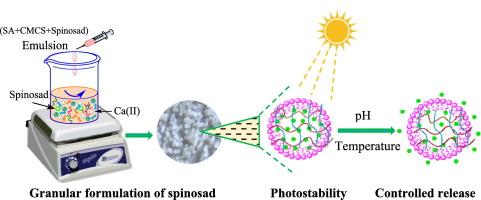海藻酸-羧甲基壳聚糖水凝胶颗粒的制备及其抗光解控释的研究
IF 5.1
3区 工程技术
Q1 CHEMISTRY, APPLIED
引用次数: 0
摘要
开发长效控释系统是提高农药药效的有效途径,特别是那些高效但易光降解的农药。本文成功制备了海藻酸钠和羧甲基壳聚糖水凝胶颗粒,用于生物杀虫剂spinosad的控释。该配方包封率为91.5%,载药量为22.3%。仪器表征(SEM, FT-IR, TGA和DSC)表明,水凝胶通过物理吸附和粘附方式包裹了spinosad,没有化学键合。与未配制的spinosad相比,spinosad在控释颗粒中的光降解率降低了50%以上,表明该制剂具有良好的紫外线屏蔽能力。体外释放曲线和溶胀行为表现出对pH和温度的双敏感性,释放动力学符合Ritger-Peppas模型的Fickian扩散机制。在鳞翅目害虫模拟肠道环境(pH 8.0 ~ 10.0)中,spinosad从颗粒中快速释放,这有助于提高其靶向效果。本研究有助于开发以天然聚合物为载体的杀虫剂控释系统,在害虫的可持续防治中具有良好的潜力。本文章由计算机程序翻译,如有差异,请以英文原文为准。

Fabrication of alginate-carboxymethyl chitosan hydrogel granules for achieving anti-photolysis and controlled release of spinosad
The development of long-acting and controlled-release systems is an effective way to improve the efficacy of pesticides, especially those that are highly effective but susceptible to photodegradation. Herein, hydrogel granules of sodium alginate and carboxymethyl chitosan were successfully prepared for the controlled release of biological insecticide spinosad. The obtained formulation displayed an excellent encapsulation efficiency of 91.5 % and a good loading content of 22.3 %. Instrument characterization (SEM, FT-IR, TGA, and DSC) demonstrated that the spinosad was encapsulated by hydrogel via physical adsorption and adhesion without chemical bonding. Compared with unformulated spinosad, the photodegradation rate of spinosad in the controlled-release granules was reduced by more than 50 %, indicating the excellent UV-shielding ability of the formulation. Moreover, the in vitro release profile and swelling behavior exhibited dual-sensitivity to pH and temperature, with the release dynamics following the Fickian diffusion mechanism of Ritger-Peppas model. Within the simulated intestinal environment of lepidopteran pests (pH 8.0 to 10.0), spinosad was observed to be released rapidly from the granules, which helps to improve its targeting efficacy. This work contributes to the development of insecticide controlled-release systems using natural polymers as carriers, with a good potential in sustainable pest control.
求助全文
通过发布文献求助,成功后即可免费获取论文全文。
去求助
来源期刊

Reactive & Functional Polymers
工程技术-高分子科学
CiteScore
8.90
自引率
5.90%
发文量
259
审稿时长
27 days
期刊介绍:
Reactive & Functional Polymers provides a forum to disseminate original ideas, concepts and developments in the science and technology of polymers with functional groups, which impart specific chemical reactivity or physical, chemical, structural, biological, and pharmacological functionality. The scope covers organic polymers, acting for instance as reagents, catalysts, templates, ion-exchangers, selective sorbents, chelating or antimicrobial agents, drug carriers, sensors, membranes, and hydrogels. This also includes reactive cross-linkable prepolymers and high-performance thermosetting polymers, natural or degradable polymers, conducting polymers, and porous polymers.
Original research articles must contain thorough molecular and material characterization data on synthesis of the above polymers in combination with their applications. Applications include but are not limited to catalysis, water or effluent treatment, separations and recovery, electronics and information storage, energy conversion, encapsulation, or adhesion.
 求助内容:
求助内容: 应助结果提醒方式:
应助结果提醒方式:


